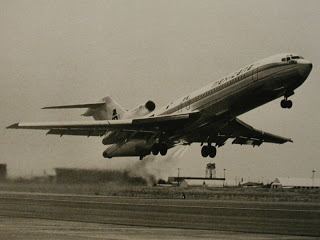Site Michoacán, Mexico Crew 8 Aircraft type Boeing 727–264 Operator Mexicana de Aviación Survivor 0 | Passengers 159 Survivors 0 Date 31 March 1986 Fatalities 167 (all) Passenger count 159 | |
 | ||
Summary In-flight fire due to maintenance error, leading to loss of hydraulic and electrical systems. Destination Los Angeles International Airport Similar Aeroflot Flight 892, Aeroflot Flight 6502, Grand Canyon Airlines Fl, Mexicana Flight 704, TWA Flight 840 bombing | ||
Mexicana Flight 940, operated by Mexicana Airlines (Compañia Mexicana de Aviación), was operating its scheduled flight route Mexico City–Puerto Vallarta–Mazatlán–Los Angeles on March 31, 1986, utilizing a Boeing 727-200 registered as XA-MEM. when the plane crashed into a mountain named El Carbón in the rugged Sierra Madre Occidental mountain range of central Mexico fifteen minutes out of Mexico City, killing all on board. With 167 deaths, the crash of Flight 940 is the worst air disaster to occur on Mexican Soil.
Contents
History
The plane, nicknamed "Veracruz" was delivered to Mexicana in 1981 and was piloted by Captain Carlos Guadarrama Sistos, an experienced Mexican captain with over 15,000 hours of flying experience. The crew of eight included five flight attendants; the wife of the captain, a retired flight attendant, and the captain's son and daughter were also among the 159 passengers on board. At 08:50 local time, the plane took off from Benito Juárez International Airport en route to Los Angeles International Airport with scheduled stopovers in Puerto Vallarta and Mazatlán.
Crash
At 09:05, fifteen minutes after takeoff, an explosion rocked the fuselage. Captain Guadarrama and the crew in the cockpit, realizing that the plane was shaking too much, declared an emergency and asked to return to Benito Juárez International Airport for an emergency landing. The airport was prepared for the landing. However, the aircraft crashed into El Carbón mountain near the town of Maravatío, Michoacán, broke in two and burst into flames. All 167 passengers and crew were killed upon impact. Eyewitnesses reported details of the crash to authorities. The local police and the Mexican army were dispatched to the crash site.
Investigation and aftermath
Initially, two Middle Eastern terrorist groups claimed responsibility for the crash. An anonymous letter signed by those groups claimed that a suicide mission had sabotaged the plane in retaliation against the United States. However, sabotage was later dismissed as a cause of the crash. The investigations were carried out by the U.S. National Transportation Safety Board and Mexican aeronautical authorities, who found that the cause of the accident was due to the center landing gear tire being filled with compressed air, instead of nitrogen. In addition, the tire had some marks of overheating. The investigators later found that the overheating was caused by a malfunctioning brake on the landing gear.
Mexicana maintenance personnel were blamed for negligence in maintaining the 727 and for filling the tire with compressed air, instead of nitrogen. The crash remains the deadliest airline disaster in Mexican history and is the world's worst air disaster involving the Boeing 727. The cause of the in-flight fire is believed to be the rupture of fuel lines by the exploding tire.
